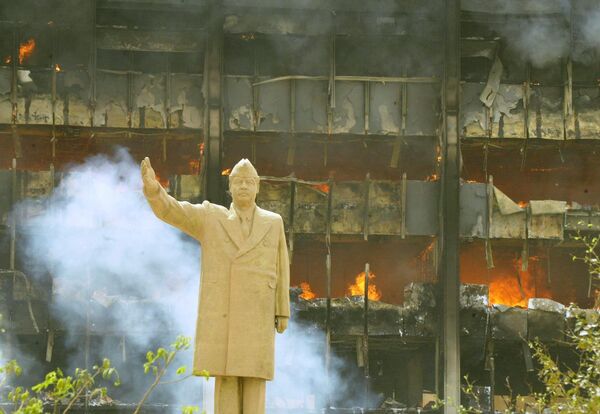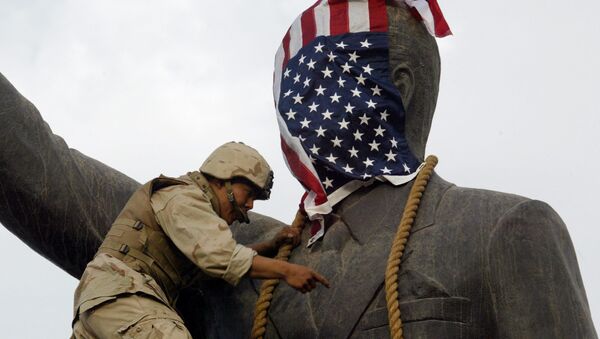Ten years ago, on December 30, 2006, the fifth President of Iraq and leader of the Baath political party, Saddam Hussein, was executed by hanging at Camp Justice, an Iraqi-American military base.
"Hussein's death was supposed to give birth to a new era in Iraq and the region. But the new era didn't last five minutes," Will Bardenwerper, a former infantry officer in the United States Army, remarked Friday in his op-ed for the Washington Post.
According to RIA Novosti political analyst Alexander Khrolenko, Hussein's death became a severe geopolitical lesson for the United States.
"The Iraq War unleashed with no sanction from the UN was illegal; it was a direct aggression against a sovereign state. The invasion of Iraq has cost the US five thousand lives of American soldiers, tens of thousands of wounded and disabled. The cost of the US' long-term "corrections" [in the Middle East] has reached the astronomical sum of six trillion dollars," Khrolenko highlighted in his recent article.
"A start has thus been made in creating the Islamic State [Daesh], designated as terrorist organization in many countries including Russia," the political analyst underscored.
In any event, the US invasion of Iraq has brought neither peace or prosperity, nor democracy to the region, Khrolenko added.
Although Iraq' crude reserves are considered to be the world's second-largest, the country is teetering on the brink of bankruptcy, while the country's army, trained and backed by the US, is unable to protect Iraq from radical Islamist thugs.
Why did the US invade Iraq?
"Following the September 11 attacks the United States declared the whole world to be the sphere of their national interest in accordance with their new security strategy. Iraq was the second state brought in the line of fire [by the US], two years after the beginning of Washington's campaign in Afghanistan," Khrolenko wrote.
"[George W.]Bush hawks knew there was no good intelligence establishing that Saddam Hussein possessed weapons of mass destruction (WMDs)," Kurt Eichenwald of Newsweek wrote in his 2015 article entitled "Dick Cheney's Biggest Lie,""Plenty of the best-informed intelligence sources were certain the WMDs were a fantasy."
Likewise, the assertion that there were ties between Saddam Hussein and Osama bin Laden "was ridiculous," Eichenwald stressed, "Bin Laden despised Saddam; he had even attempted to organize an Islamic army to fight the Iraqi strongman after he invaded Kuwait in 1990."
However, that did not prevented Washington and its NATO allies from invading and occupying the sovereign state, Khrolenko pointed out.

Washington destroyed Hussein's security system opening the door to al-Qaeda. Following the US invasion of Iraq ethnic and religious violence engulfed the war-torn country.
The analyst remarked that American soldiers "failed to win hearts and minds of the Iraqis." As a result, more than one million Iraqis have died since the US-led invasion of 2003, according to Britain's leading polling groups.
"Billowing smoke now obscures the sunrise in towns across the Middle East 10 years after Hussein's execution, and 13 years after Bush's promise that 'a free Iraq is going to be one that will have an amazingly positive effect on its neighborhood.' The neighborhood is a now a charnel house," Bardenwerper writes, recalling Saddam's words "You'll wish you had me back."
In 2006 former President of Yugoslavia Slobodan Milosevic died in his prison cell, seven years after NATO had bombed Belgrade into obedience.
In 2011 Washington did not prevent the Islamist mob from murdering Libyan leader Muammar Gaddafi. "We came, we saw, he died," then-US Secretary of State Hillary Clinton said with laughter commenting on Gaddafi's death.
"Many in the West really believe that the modern world was largely created by the United States… In case of any problems or disagreements it is preferable for [Washington] to eliminate dissent 'dictators' and dismantle 'rogue states'," the analyst pointed out.
However, "the sole superpower's" geopolitical game has turned out to be ineffective, its Middle Eastern "house of cards" is collapsing, while Washington struggles to save its face and get out of the endless war it unleashed in the region, Khrolenko emphasized.
The US influence in the Middle East is fading with Iraq and Syria turning to Russia and powerful regional allies to get rid of the terrorist threat.




